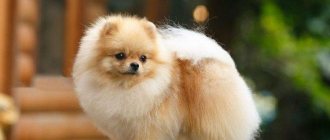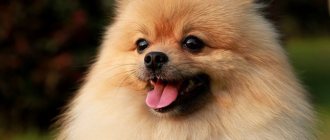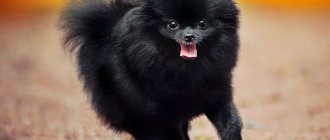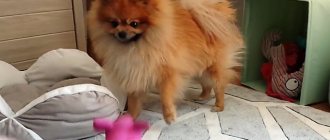The Pomeranian with fur whiter than snow looks very cute.
On the streets, such a dog always attracts the attention of passers-by, and at exhibitions it looks very impressive.
However, the white color in this breed is not the easiest to breed.
In addition, caring for such a Spitz is somewhat more labor-intensive than caring for a dog with a less distinguished coat color.
What breed characteristics do white Pomeranians have and what should you consider when choosing such a pet?
History of the Pomeranian Spitz breed
Pomeranian Spitz puppy
Looking at the little ball curled up comfortably in a chair, it is difficult to imagine that his ancestors were several times larger and lived in the territory of modern Northern European countries. Archaeological burials of the Neolithic era serve as evidence of this. The so-called turf dogs were used for transportation due to their endurance and strength. It is worth noting that this method is still widespread in Iceland and Lapland. In the southern territories, these dogs were bred to guard ships in ports or property. The Middle Ages radically changed the attitude towards them: their pretty appearance and indomitable energy earned the love of the European aristocracy. Increasingly, noble ladies and august persons appeared at social events in the company of a four-legged companion.
Residents of Germany were the first to show sincere interest in the breed from which the Pomeranian spitz originated. It was here that Spitzhund dogs began to be bred, which by the 18th century had spread throughout the medieval state. For a long time, cynologists could not come to an agreement: where did the Pomeranian Spitz come from? The laurels passed either to the German city of Württemberg, the center of dog breeding, or to Pomerania, a Prussian province. Many experts have made bold statements comparing Spitz dogs to dogs that lived in China, Ancient Egypt and Greece. As a result, the right to be considered the birthplace of this breed was assigned to Pomerania.
The first individuals weighed about 15 kilograms and were larger than modern Pomeranians. Wanting to make the breed more compact, German dog breeders selected the smallest specimens for breeding. This business was continued in England, where the Pomeranian Spitz “sparkled” with new colors.
Queen Victoria played an important role in recognizing the breed. Like many before, she could not resist the charm of Marco, a Pomeranian who met the queen in Florence and soon went with her to England. Over time, this made the breed popular. Repeated victories of the Royal Spitz at various shows and exhibitions aroused the desire of the townspeople to acquire the same charming pets. At the end of the 19th century, the Pomeranian was recognized as a breed awarded a separate dog breeders club. It consisted mainly of noble ladies, many of whom later founded the first nurseries, where they bred and kept Pomeranian Spitz dogs, often of a certain color. For example, one of the nurseries was famous for animals with cream and white coats, while in another one could find specimens of black shades.
Trimmed Pomeranian Spitz
Pomeranian Spitz
The efforts of English dog breeders made it possible to change the size of the Pomeranian Spitz, which became significantly smaller in comparison with their German relatives. All animals were divided into two groups: individuals weighing less or more than seven pounds (about 3.1 kilograms). As a result of many years of selection, English Pomeranians became the standard that breeders from all over the world tried to meet. However, to this day the most miniature of the Spitz dogs are those from Pomerania.
Pomeranian Spitz white and two-tone colors
Back in 1892, this breed also conquered the inhabitants of America, where the dogs were brought from English kennels. Despite the fact that Pomeranians were not recognized by the American Kennel Club (AKC), a well-known canine organization that still exists, the animals were immediately loved for their enthusiasm, playful behavior and, of course, silky fur. Everything changed at the beginning of the 20th century, when the founding of the Pomeranian Club of America marked a milestone in the process of recognizing the breed.
Eleven years later, the first exhibition was held, where numerous Pomeranian breeders competed to become the best. By that time, Spitz could boast a whole palette of colors. Animals in black, white, chocolate, cream and blue shades aroused everyone's admiration, but only one Pomeranian received the highest award. It was Banner Prince Charming with wool of a noble black shade, which belonged to Mrs. F. Smith. Famous champions of subsequent exhibitions were the Pomeranian Spitz Dainty Might (Graceful Baby), Princess Ula and Twilight (Dusk). All of them gave birth to numerous offspring.
Pomeranian Spitz compared to humans
Despite the visible progress in the selection of Pomeranian Spitz, American dog breeders continued to work on improving the breed, but soon abandoned the attempt to make the animals more miniature. A strong decrease in body proportions led to the inability to procreate, which negatively affected the breeding of dogs. It was experimentally revealed that maintaining the blue color of Pomeranians is the most difficult, and white Spitz looked larger than their relatives with a different coat color and therefore participated less often in exhibitions.
It is worth noting that it was on the American continent that the correct name was assigned to the breed - Pomeranian. The rest mistakenly called the Spitz either German or dwarf. Nowadays this trend is less common, although in the FCI (International Canine Organization) classification Pomeranians are still registered under the name “German Spitz”.
This breed has come a long but interesting way from northern service dogs to the favorites of noble people. Now Pomeranians are regular participants in various exhibitions and events. Animals delight us with their intelligence, perky character and thick fur, inherited from their ancestors. Compact size combined with a big heart makes Pomeranians excellent companions and loyal friends.
Toys
Pomeranians are big fans of entertainment and fun. Each dog has an individual character, so they like different toys. They come in several types. Some are intended for the street, for example, flying saucers, rings, so that the dog can run around to his heart's content.
Expert opinion
Anna Abramenko
An avid dog lover. Experience in veterinary medicine since 2009.
Ask a Question
It is worth noting that you should not let your Spitz chew sticks, as the wood chips can clog the stomach and damage it.
Other toys are used at home. They are divided into edible and inedible. The first type can not only entertain the Spitz, but also prevent the appearance of plaque and tartar on the teeth. Such toys are made from offal (ears, paws, legs), they are absolutely safe, and attract the dog with their taste and smell. The choice of inedible toys is much wider. They have different shapes and sizes. Most of all, Pomeranians love balls that can be bitten and chewed.
Expert opinion
Anna Abramenko
An avid dog lover. Experience in veterinary medicine since 2009.
Ask a Question
The owner should not buy a lot of toys. Dogs are not much different from children, so their abundance can lead to the fact that they all get bored quickly.
Appearance of a Pomeranian Spitz
The Pomeranian is a dwarf dog breed. However, his dense physique and strong muscles do not detract from his grace and grace. The FCI standard suggests that the height of a Spitz at the withers should be equal to the length of its body and be 18-22 cm.
The weight of oranges is proportional to their height and ranges from 1.5-3.2 kg. Exhibition representatives of the breed should ideally weigh 2 kg.
Head and skull
Walking Pomeranians
The head of the Pomeranian Spitz is small in size. The wide back of the skull tapers towards the nose, thereby forming a wedge. The rounded forehead contrasts with the insufficiently pronounced occipital protuberance. Cheekbones are practically invisible due to chubby cheeks.
Muzzle
A well-defined stop is a characteristic feature of the narrow muzzle, which is half the size of the skull. The small and neat nose is always black (may be brown in orange and red colored specimens). The situation is similar with lip color.
Ears
The triangles of the ears “stand” close to the top of the head. They have a sharp and hard tip. At birth, the Pomeranian's ears are droopy, but they "pick up" as the dog matures.
Eyes
White pug
Small dark eyes are set askew. The shape is mostly almond or oval. Eyelids black; dark brown pigmentation is acceptable in dogs of similar color. The Pomeranian has a lively and even mischievous look, which gives the animal a resemblance to a fox cub.
Jaws and teeth
The Pomeranian's upper jaw overlaps the lower jaw, thereby forming a regular scissor bite. Straight and pincer bites are not recognized as a defect. There are 42 teeth. The absence of premolars in the Pomeranian is not critical.
Neck
The strong neck has a slightly arched shape. The length is average, there is no so-called dewlap. The high waist is masked by a lush frill.
Pomeranian Spitz face
Frame
The Pomeranian's neck ends at the withers, and that ends at the short back. The loin, in turn, goes into a short, unsloping croup. The chest is developed. The abdomen should be tucked in and the ribs should be palpable.
Tail
Black Pomeranian Spitz
It has a medium length and is located relatively high. Due to the fact that the tail ring lies on the back, the dog looks miniature and round.
Forelegs
Set wide apart. The shoulders are distinguished by pronounced muscles. Tightly fitting fingers evoke associations with the neat paw of a cat. The black tint of the pads and claws is characteristic of all representatives of the breed, except red, cream and brown.
Hind limbs
Parallel to each other. The thighs and shins are in equal proportions. The small paws are not as round as the front paws. The toes are compressed and end in black claws and pads (brown in some dogs).
Movement style
The Pomeranian moves easily and flexibly. The hindquarters have good drive. The dog springs a little when walking.
Coat
The orange's fur hides a dense undercoat. Short soft hair covers the head, perky ears and the front side of the limbs. The remaining part of the body is distinguished by long, straight hair, which is not characterized by the presence of curls and waves. The dog's shoulders and fur are hidden by the mane. The fluffy tail blends smoothly with the “pants” on the hind legs.
Color
Little bear
The Pomeranian breed has ten coat colors: white, blue, black, cream, orange, sable, blue or black and tan, chocolate and two-tone. Spotted color implies white as a background color and an even distribution of markings.
A breed defect is any deviation from the standard. Among them:
- sharp narrowing of the skull from the back to the nose;
- the head is apple-shaped or too flat;
- watery, bulging eyes, their light shade;
- bodily pigmentation of the eyelids, nose and lips;
- waddling gait, “prancing”;
- double ring at the end of the tail;
- pronounced stop.
In addition, there are also disqualifying defects:
- aggressive or cowardly behavior;
- unhealed fontanel;
- half erect ears;
- undershot and/or undershot;
- eversion or inversion of the eyelids;
- clear boundaries of white spots.
In Pomeranian males, two developed testicles should be completely contained in the scrotum.
Kinds
Thick coat is the main parameter of the attractiveness of the Pomeranian Spitz breed . According to the standard, many variations of its color are allowed. But, most often, these decorative dogs are born red or sandy.
Important ! Only by 6 months of life can you accurately determine what the fur color of a Pomeranian Spitz will be.
Acceptable dog color options:
- Pure white.
- Ginger.
- Reddish.
- Sand.
- Creamy beige.
- Sable.
- Orange.
- Pure brown.
- Pure black.
- Blue with brindle.
Photo of an adult Pomeranian Spitz
Interesting Facts
Spitz dogs love to bark because they love to hear their own voice .
In Anton Pavlovich Chekhov's work “The Lady with the Dog” we are talking about a Pomeranian Spitz.
Two Pomeranians from the Rothschild dynasty were rescued from the sinking the Titanic
Pomeranians have become the favorites of many celebrities . They live with Maria Sharapova, Sharon Osbourne, Nicole Richie, Sylvester Stallone, Mickey Rourke, Eva Longoria.
Previously, this breed was called the German Miniature Spitz .
Character of the Pomeranian Spitz
Owners of charming Pomeranians note their good-natured character, unbridled curiosity and cheerful enthusiasm with which the fluffy buns explore the world even within the confines of an apartment. You should not get a Spitz as a decorative dog with whom you can lie on the couch and watch your favorite movie. The Pomeranian prefers active games, and a walk in the fresh air is a delight. A dog of this breed will happily fetch a thrown ball, chase a pigeon nestled on the curb and rush to protect its owner from the “threat”. In general, a fun walk with your fluffy fidget is guaranteed.
Spitz in a bicycle basket
The Pomeranian Spitz easily finds a common language with its owner, adapting to his lifestyle. A faithful dog will never make noise early in the morning if you prefer to get up around noon, and will follow on your heels as soon as you wake up. Representatives of this breed are attached to the family in which they live and can become sad if they are not given due attention. Many Spitz owners note that returning home after work is fraught with a remarkable show of love from the little bear. The dog will always be by your side: while cooking dinner, taking a shower and sleeping at night. Some animals can sleep in the room with their owner (sometimes next to them on the bed) in order to please them in the morning with another portion of affection and a loud call to take a walk in the city park.
The Pomeranian has a tendency to bark and responds with a booming “voice” to any suspicious rustle. This dog makes an excellent watchman who will scare away an uninvited guest, forgetting about his miniature size. Sometimes a Spitz may bark for no reason, and then the owner will have to gently correct his pet’s habit.
Spitz with his beloved owner
If you are planning to adopt a Pomeranian as a friend for your child, your attitude towards the new family member should be conscious and careful. Pomeranians will happily join children in a fun game if they are used to their company as a puppy. Otherwise, the dog will prefer to remain an outside observer.
The Pomeranian Spitz behaves reservedly with strangers and only in the absence of proper upbringing can it bark at a random passerby. The dog reacts warily to universal affection and not everyone will allow him to run his fingers through the soft plush fur.
The Spitz gets along well with other animals, but sometimes shows the habit of dominating its relatives. The appearance of a second dog in the house is an alarm bell for the Pomeranian: you need to show the owner and the new furry scoundrel who is boss in the house. However, if the Spitz grew up with other animals, these problems will not arise. Be careful when introducing your pet to decorative rats, hamsters, parrots and others: the Pomeranian's hunting instincts can appear at the most unexpected moment.
Vaccinations
Vaccination is a mandatory procedure. Dogs are susceptible to dangerous infections, some of which are fatal. A newborn puppy is protected by maternal antibodies. At two months the first distemper vaccination is given. Revaccination is carried out after 2 weeks. At 6 months, Pomeranians change their teeth, at which time they are again vaccinated against distemper, as well as against hepatitis, enteritis, and adenovirus. The Spitz is revaccinated every year. In the future, vaccinations are repeated annually.
Before the first vaccinations, the pet should not be taken outside, as it is absolutely defenseless against infections. In the future, after vaccination, a two-week quarantine must be observed.
Vaccination is carried out if the dog is absolutely healthy, otherwise it is better to postpone it. 5 days before vaccination it is necessary to carry out deworming. The dog must have a veterinary passport, in which the doctor marks the administered vaccines.
Education and training
Training a Pomeranian Spitz
The Pomeranian Spitz is naturally gifted with highly developed intelligence, which greatly facilitates the learning process (compared to other decorative dog breeds). However, a stubborn and independent character can become a serious obstacle to following commands. Forget about traditional training methods: in this case they do not work. You will have to find a special approach to your pet.
The main thing in raising a Pomeranian is to forget about its touching appearance. Often, the owners of these dogs treat them like children, considering their pets small and not yet capable of carrying out complex commands. The Pomeranian Spitz needs a confident owner who can show strength of character and has leadership qualities. Only in this case does the dog willingly give in to training, learning both basic commands and tricks worthy of circus performances. If a Spitz considers himself a step above you, he will pointedly refuse to listen to any admonitions or requests to sit, lie down, or raise his voice.
Gentle handling of your pet and tasty rewards are the most effective approach to training this breed. The Pomeranian does not like criticism and responds to displays of cruelty or disrespect with willfulness, insolence, or even aggression. A disobedient dog will bring a lot of trouble to the owner, so first you need to teach your pet to perform the simplest actions: sit, lie, approach the leg, go to the place. The command to stop barking is no less useful: the high and ringing intonations of the “voice” will not appeal to everyone.
In general, dog breeders characterize the Pomeranian Spitz as a smart creature that is easy to train with the right approach to training. The only thing that may cause problems is toilet training. Due to the peculiarities of the Pomeranian’s structure, it is difficult for the Pomeranian to retain the contents of its bladder for a long enough time, so the dog can relieve itself right in the apartment. However, if you have the patience to teach your pet to ask for a walk on time, the cleanliness of your home will remain intact. Particularly creative dog breeders teach their Spitz to go to the cat litter box.
Tray training
The Spitz usually relieves itself during walks, but it also needs to be trained to use the toilet at home. An ordinary plastic tray, the bottom of which is covered with disposable diapers, is quite suitable for this.
This is interesting: How to teach a Pomeranian to go to the toilet in a diaper
Training must begin from the very first day the puppy appears in the house. As soon as the Spitz wants to relieve itself, it will begin to sniff corners. At this moment, he is carefully transferred to the tray and care is taken that he does not escape. This must be done until the owner is firmly convinced that the puppy has remembered the lesson. The main thing is to show persistence and patience.
Expert opinion
Anna Abramenko
An avid dog lover. Experience in veterinary medicine since 2009.
Ask a Question
It would be a good idea to purchase antigasin in case the Spitz did go to the toilet in the wrong place. Under no circumstances should you scold him for this, much less beat him. Otherwise, the puppy will experience stress and next time relieve itself in a place secret from the owner.
Care and maintenance
Long and fluffy hair is the main asset of Pomeranians, so the lion's share of care comes from careful combing. Representatives of this breed shed twice a year. In this case, the first shedding occurs in the fourth to sixth month, when the puppy’s down is replaced by “adult” fur. In Pomeranian Spitz bitches, shedding begins during estrus and after giving birth, so don’t be alarmed. However, constant bald spots should make you think about changing your pet’s diet and selecting new coat care products.
It is not recommended to bathe oranges more than once or twice a month (as needed). To do this, use diluted shampoo for long-haired breeds: a concentrated product may have the opposite effect. Be sure to condition the dog’s velvety fur with conditioner and dry it thoroughly with a hairdryer. Use a long-toothed comb or slicker brush. Please note that when combing the coat should be damp, so you should always have water softened with the same conditioner on hand. The molting period requires more thorough combing with a comb.
Thinning scissors are used to trim orange blossoms. Basically, the coat is shortened to maintain the dog's neat appearance. For hygienic purposes, Spitz owners trim the space between the paw pads and the area under the tail. Do not use the “machine” under any circumstances! This will disrupt the natural structure of the hair, which in the future can lead to the regular appearance of tangles in the hair.
Pomeranian teeth are brushed with a special paste 3-4 times a week. You can use a brush or attachment for this. A piece of bandage wrapped around your finger will also work. To avoid the appearance of tartar and further treatment, it is recommended to include solid food in your pet’s diet.
Nails are trimmed using a nail clipper for toy breeds. Don't forget to file away any sharp edges. The paw pads also deserve care: rub vegetable oil into them - and painful cracks will never bother your pet!
The orange's diet should be balanced. Dry food with the maximum content of essential minerals and vitamins is suitable for this. Natural food is no less healthy, but under no circumstances should you treat your Spitz to food from the table:
- sweets;
- milk;
- smoked meats;
- flour products;
- fatty and spicy foods;
- river fish.
Food should always be fresh and at room temperature. Do not forget about a sufficient amount of water, which needs to be changed daily.
Feeding your orange
Poor quality nutrition can lead not only to deterioration of the coat condition, but also to health problems for the pet.
Feeding your Pomeranian affects the condition of its coat.
This active animal requires a balanced diet. You can use premium dry food. At the same time, you can also give natural products. Food should be high in calories and rich in beneficial compounds. The basis of the diet is lean meat and fish. In addition, you can give your animal:
- chicken and salmon fat;
- spinach;
- green beans;
- peas;
- bell pepper;
- carrot;
- zucchini;
- oatmeal;
- rice porridge;
- potato;
- quinoa;
- boiled eggs;
- plain yogurt;
- low-fat cottage cheese.
In addition, small quantities of fruit can be given to your dwarf Spitz.
At the same time, you should not feed your dog smoked meats, sweets, spicy dishes and flour products. In addition, it is not recommended to give your Miniature Spitz whole milk.
Pomeranian Spitz Health and Diseases
The Pomeranian's northern origin has given it good health compared to other dwarf breeds. Even in old age, these lively cubs feel great.
Pomeranian Spitz on a walk
The thick coat explains the oranges' predisposition to matting. Some dogs suffer from alopecia - baldness of certain areas of the body. The so-called black skin disease, which is fraught with complete hair loss and pigmentation of the skin, looks especially frightening. However, the disease itself does not harm the health of the Spitz, limiting itself only to the unattractive appearance of the animal.
Merle-colored Pomeranians are most susceptible to disease. They are born deaf, with increased intraocular pressure and coloboma - a defect in the lining of the eyes. There are disturbances in the functioning of the cardiovascular, musculoskeletal and nervous systems.
Typical diseases of Pomeranians include:
- ligament weakness;
- subluxation of the knee joint;
- dysbiosis of the gastrointestinal tract;
- colitis and gastritis;
- cough caused by spasm of the larynx;
- tearfulness;
- atrophy of the retina and tear duct;
- hypoglycemia;
- hydrocephalus.
Rare diseases include tumors and undescended testicles in male dogs.
Prevention of parasites
All parasites that infect domestic animals are divided into two types:
- Internal - worms.
- External – fleas, ticks.
The best way to protect against these scourges is prevention. Combing the Spitz is carried out over a white cloth, so you can notice flea damage in time. This is also evidenced by the pet's constant scratching and hair loss. If an infection occurs, you need to buy special products in the form of drops, an aerosol or a collar from a veterinary pharmacy.
Ticks are dangerous parasites that carry serious diseases. During the season of their spread, the dog must be carefully examined after a walk, and drops must be used.
Prevention of worms is also necessary for the Spitz, because they greatly weaken the body. They fight their appearance with deworming three times a year. It is carried out not only on the Pomeranian, but simultaneously on all pets and people.
How to choose a puppy
Before you take a new pet into your home, you need to decide on its future fate. Show-class puppies are the best suited for participation in exhibitions. Breed-class dogs are purchased mainly for breeding. If you see a Pomeranian Spitz as a wonderful friend and companion, pay attention to pet-class puppies - and you won’t go wrong.
The future dog owner must understand that there is no 100% guarantee. Not all representatives of the show class take pride of place at exhibitions, just as not all breeding class bitches are distinguished by their fertility. If this is important to you, it is better to get a Pomeranian from experienced breeders who pay due attention to proper dog breeding. Although we must not forget that even a pet-class baby can be raised into a champion if he fully complies with the breed standard.
When choosing a Pomeranian puppy, you need to pay attention to its health and appearance. A healthy baby should be lively, playful and high-spirited, show curiosity towards you and not be afraid of an outstretched hand. The size of the puppy should not determine your choice: even the smallest specimen can grow into a large dog.
The sex of the baby in most cases determines his behavior in the future. Males are distinguished by cockiness and stubbornness, while females are tender and flexible, although there are exceptions.
Food allergies
For dogs with allergies, many manufacturers have produced hypoallergenic food.
A Spitz can be allergic to any product. This often happens when switching from natural to ready-made food or vice versa. But a product familiar to a dog’s diet can also become an allergen. The first symptoms are scratching of the pet, lacrimation, and stool disturbances. If they appear, the Spitz should be given an antihistamine and taken to a specialist. The veterinarian will be able to reliably determine the cause of the allergy and prescribe the correct treatment.
Photos of Pomeranian Spitz puppies
How much does a Pomeranian cost?
The price of a puppy depends on several factors.
Offspring from elite females and males cost from 50 to 100 thousand rubles. For 30-50 thousand you can take a Pomeranian from a more modest family. A furry baby without documents costs up to 15 thousand rubles. Remember that a female is valued several times more expensive than a male. It is best to buy a Pomeranian puppy from an official kennel that breeds this breed. This way you will get a faithful friend with excellent health and inexhaustible optimism.
brief information
| ICF classification | 5. Spitz and primitive breeds |
| 4. European Spitz | |
| Country of origin | Germany |
| Weight | 1.4-3.5 kg |
| Height | 17-24 cm |
| Wool | Long with dense undercoat |
| Color | White, black, brown, wolf, orange, orange-sable, cream, cream-sable, black and tan, black-white, brown-white, white-wolf gray, white-orange, white-orange-sable, white-cream , white-cream-sable |
| Life cycle | 12-16 years old |
| Immediate family | German Wolfspitz (Keeshond), German Spitz miniature (small) |











